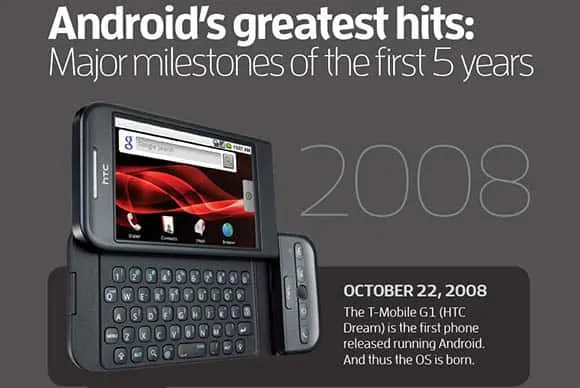You would have had to have lived in a deep hole on the darkside of the moon in order to not have witnessed the meteoric rise of the Android operating system. From the launch of the HTC G1 way back in 2008, with Android version 1.5 Cupcake being released in April 2009, the world has seen Android take on all comers, becoming the most popular mobile operating system in the world. And with Google’s Sundar Pichai announcing that they had passed the 1 billionth Android activation back in September, there doesn’t seem to be any sign of Android slowing down.
Here is a fantastic infographic (courtesy of techhive) depicting the birth of Android, and charting its journey to its billionth activation, which in a couple of weeks will see the release of Google’s newest Nexus devices, as well as the release of Android 4.4 KitKat.
It’s easy to forget that the Android Revolution began as a HTC G1 (Dream), over 5 years ago. I myself climbed aboard the Android bandwagon with the purchase of the HTC Hero (the one with the chin) after deciding that almost anything would be better than the Nokia N97, which was the most frustrating phone I’ve ever had the misfortune of owning. The difference between Symbian and Android Cupcake was so vast it blew my mind. The HTC Sense overlay was so beautiful when compared to the blandness of Symbian, and when coupled with the ability to put widgets on the home screen and install proper apps on the phone, via a fit-for-purpose app instead of the Nokia’s woefully slow and unhelpful Nokia-store interface, well, Android was a proverbial breeze of fresh air.
Android has moved on from those days, with the release of a separate version for tablets that saw the Motorola Xoom boasting Honeycomb 3.0, which was later merged with the mobile version GingerBread 2.3 to form Ice-Cream Sandwich 4.0 that showed off a new design language – ‘Holo’ . In the present time Jelly Bean 4.3 is making its way to our current devices, with Android version 4.4 KitKat due for release in the coming weeks.
From the release of the HTC Nexus One, offering consumers the very first taste of what would become known as the Google Experience, Android has seen the range of Nexus devices grow, with the Nexus 4 and Nexus 7 range of devices becoming best-sellers the world over. The Nexus Q being the only fly in the ointment, the media streamer being discontinued relatively soon after release, and given away for free to people who had placed pre-orders . Currently we are awaiting the imminent release of the LG Nexus 5 and possibly a replacement for the Nexus 10 tablet.
Whilst we are feeling nostalgic, what was your first Android phone? Which device or operating system were you using before you switched to Android? And the 64 trillion-dollar question, where do you think Android will be after the next 5 years? As always, let us know in the comments or on our Google Plus Page.

